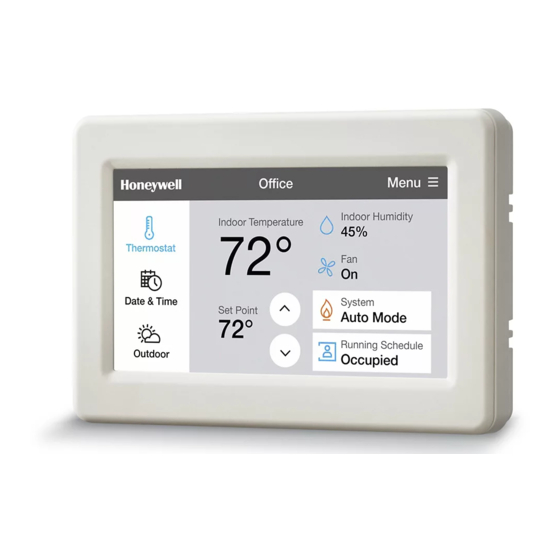
Honeywell LCBS Connect Quick Start Manuals
Hide thumbs
Also See for LCBS Connect:
- Installation instructions (4 pages) ,
- Applications manual (44 pages)
Available languages
Available languages
LCBS Connect
Quick Start Guide
Gateway
Wiring
The LCBS Connect Gateway and Controller use a Free Topology Transceiver (FTT) architec-
ture which supports polarity insensitive and free topology wiring. This allows for any mixture
of wiring topologies (Daisy Chain preferred) and simplifies network expansion by eliminating
restrictions on wiring routing, splicing and device placement.
The LCBS Connect Gateway can support up to THIRTY Controllers. The local and remote user
interfaces will display the number of discovered controllers on the network for easy trouble
shooting. The LCBS Connect network is flexible and convenient to install and maintain, but it
is important to carefully plan the network layout and create and maintain accurate documen-
tation. For advanced network configurations, including the use of an end-of-line terminator
(209541B), refer to 'LonWorks® Bus Wiring User Guide' (74-2865).
Recommended Wire
The LCBS Connect network includes two rules to be met for proper system operation:
1
The distance from each device to all other devices must not exceed the maximum device-
to-device distance.
2
The maximum full network wire length is the total amount of wire connected per network
segment.
Wire/Cable Type (Unshielded)
Honeywell Cable 1125 (Stranded Non-
Plenum)
Honeywell Cable 1061, 1062, 1063 (Solid/
Stranded Twisted Pair)
Honeywell Cable 5078, 5088 (Solid or
Stranded, Plenum or Non-Plenum)
T-TAP
DAISY CHAIN
AWG
Device-to-Device
16
1640 feet
(500 meters)
22
1300 feet
(400 meters)
24
820 feet
(250 meters)
Full Network
1640 feet
(500 meters)
1640 feet
(500 meters)
1500 feet
(450 meters)
31-00115EFS-01
Table of Contents

Summary of Contents for Honeywell LCBS Connect
-
Page 1: Quick Start Guide
(Daisy Chain preferred) and simplifies network expansion by eliminating restrictions on wiring routing, splicing and device placement. The LCBS Connect Gateway can support up to THIRTY Controllers. The local and remote user interfaces will display the number of discovered controllers on the network for easy trouble shooting. -
Page 2: Connections And Leds
Connections and LEDs The LCBS Connect Gateway serves as the main communication device between a building site and the Honeywell Cloud. It has been designed to provide simple, intuitive status indicators, including colored LEDs and icons, to ensure correct connections have been made upon instal- lation. - Page 3 Controller Application The LCBS Connect RTU Controller is designed to control constant volume air handling units, specifically packaged roof top units (RTU) including heat pumps. It consists of a configurable controller and a wall module which are connected via Sylk™ bus. The controllers are capable of stand alone operation but optimal functional benefits are achieved when connected to the LCBS Connect Honeywell Cloud.
-
Page 4: Reference Documents
By using this Honeywell literature, you agree that Honeywell will have no liability for any damages arising out of your use or modification to, the literature. You will defend and indemnify Honeywell, its affiliates and subsidiaries, from and against any liability, cost, or damages, including attorneys’ fees, arising out of, or resulting from, any modification to the literature by you. -
Page 5: Guide De Démarrage Rapide
à distance affichent le nombre de régulateurs repérés sur le réseau pour faciliter le dépannage. Le réseau LCBS Connect est polyvalent et facile à installer et à maintenir. Il est néanmoins important de planifier soigneusement sa configuration T-TAP et de disposer d’une documentation précise faisant l’objet de mises à... -
Page 6: Connexion Internet
La passerelle LCBS Connect agit comme dispositif de communication principal entre un immeuble et le nuage Honeywell. Elle est munie de témoins d’état simples et intuitifs comprenant des DEL colorées et des icônes qui vous permettent de vérifier la validité des connexions réalisées lors de l’installation. - Page 7 Régulateur Application Le régulateur RTU LCBS Connect est conçu pour contrôler des appareils de traitement d’air à volume constant, et plus particulièrement des appareils monoblocs installés sur le toit (RTU) comprenant des thermopompes. Il comprend un régulateur configurable et un module mural connectés par un bus Sylk™.
- Page 8 à tout dommage qui découlerait de votre utilisation ou de votre modification de la documentation. Vous consentez à défendre et à indemniser Honeywell, ses filiales et ses succursales, à l’égard de toute responsabilité, de coûts ou de dommages, y compris des frais d’avocat, qui pourraient être invoqués ou résulter de toute modification apportée de votre part à...
-
Page 9: Guía De Inicio Rápido
Puerta de enlace Cableado La puerta de enlace y el controlador LCBS Connect usan una arquitectura de transceptor de topología libre (Free Topology Transceiver, FTT) compatible con un cableado de topología libre, insensible a la polaridad. Esto permite una mezcla de topologías de cableado (se recomienda la topología cadena margarita) y facilita la expansión de red mediante la... - Page 10 La puerta de enlace LCBS Connect funciona como el dispositivo de comunicación principal entre el edificio y la nube de Honeywell. Su diseño ofrece indicadores de estado simples e intuitivos, incluidos los íconos y los indicadores LED de colores, que permiten comprobar si las conexiones se realizaron de forma correcta durante la instalación.
- Page 11 Controlador Aplicación El controlador de las unidades de techo (Roof Top Units, RTU) LCBS Connect está diseñado para controlar las unidades manejadoras de aire de volumen constante, específicamente las unidades de techo integradas (RTU) e incluidas las bombas de calor. Se compone en un controlador que se puede configurar y un módulo de pared que se conectan a través del...
- Page 12 • Instrucciones de instalación para la puerta de enlace LCBS Connect (31-00081) • Manual de uso LCBS Connect (31-00118) Al utilizar esta publicación de Honeywell, usted acepta que Honeywell no será responsable de los daños provocados por su uso o modificación de la publicación. Usted protegerá e mantendrá indemne a Honeywell, sus afiliadas y subsidiarias de cualquier responsabilidad, costo o daños, incluidos los honorarios...















